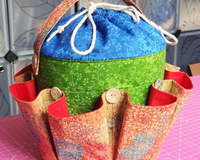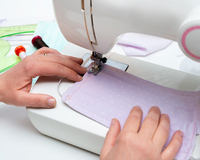Cotton is one of the few natural fibres that are used in clothing, bedding and other household products. But where does this material come from and how is it made?
The process begins with the cotton plant, which grows in warm climates including: Egypt, Africa, the United States, China, Pakistan and India.
Cotton fibre, which has the appearance of cream coloured, soft, fine, fluffy hairs is found wrapped around the seeds of the cotton plant.
The fibres are separated from the seeds and cleaned, they are then aligned and straightened by the process of carding and combing through metal teeth. The fibres have a rough texture which are bonded together, this enables the fibre to be strengthened and spun to create cotton yarn, the yarn is then woven or knitted to create cotton fabric of many varieties.

This process is known to go back as far as 5000BC in the geographical areas now known as Peru and Mexico. The production was also practiced in ancient Egypt, India and Pakistan where cotton plants grew and were easily accessible.
With the advance in world transport and trading links, cotton fabric production spread to the West, including the UK. Initially the production was by way of a cottage industry, families undertaking the process of spinning and weaving at home with merchants delivering the raw cotton to them and collecting the finished product. Traditionally women and children spun the yarn. The yarn was then passed to a weaver, usually a man to work the hand loom.
The invention of the spinning machine in the late eighteenth century revolutionised cotton production. A shift from the cottage industry towards state of the art factories producing cotton on an industrial scale took place. Lancashire became the home of cotton production changing its landscape completely to a blanket of mills and chimneys, epitomised perfectly in the art work of L.S. Lowry.
Towards the end of the nineteenth century seventy five per cent of world cotton production took place within the triangle of Manchester, Burnley and Preston.
Lancashire was the perfect location, the Port of Liverpool provided a route for the raw cotton from America. The cool, moist damp climate of Lancashire provided perfect climatic conditions for working the cotton during production and the rivers and streams provided the power to drive the water wheels to turn the machinery. Coal from local mines was later used as the predominant fuel to drive the steam machines. The two industries; cotton and coal production defined the history of Lancashire for years to come

At Always Knitting and Sewing we embrace our historical heritage link, although now long gone, mills and chimneys dominated the Chorley sky line, along with our Lancashire neighbours; Bolton, Blackburn and Burnley.
There is still a reminder for us nearby as there is still a Victorian chimney standing which is now part of Morrison’s supermarket in Chorley. This has been preserved from when it was part of The Victoria Mill, an historical relic of Lancashire’s proud cotton producing past.






